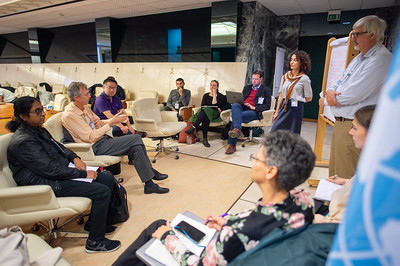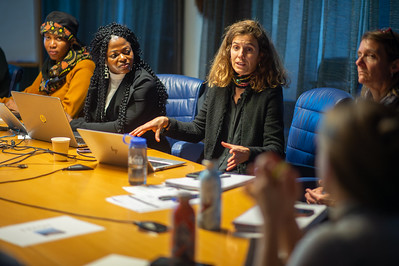Charting the course for global restoration
FAO and CBD host a global event on developing a roadmap for the Kunming-Montreal Global Biodiversity Framework Target 2
In a pivotal gathering from November 22nd to 24th, 2023, the Food and Agriculture Organization of the United Nations (FAO), the Secretariat of the Convention on Biological Diversity and the UN Environment Programme (UNEP) hosted a landmark event aimed at advancing the Kunming-Montreal Global Biodiversity Framework (GBF) Target 2 at FAO headquarters in Rome, Italy. Part of a broader ongoing process, the event brought together global experts, academia, country representatives, non-governmental organizations, Indigenous Peoples and local communities, to collaboratively build a roadmap for GBF Target 2 that sets the ambitious goal of at least 30 percent of degraded terrestrial, inland water, and marine and coastal ecosystems being under effective restoration by 2030.
|
GBF Target 2. 30% of degraded areas are under effective restoration: Ensure that by 2030 at least 30 per cent of areas of degraded terrestrial, inland water, and marine and coastal ecosystems are under effective restoration, in order to enhance biodiversity and ecosystem functions and services, ecological integrity and connectivity. |
The three-day event featured a comprehensive agenda, covering sessions on progress and alignment between the UN Decade on Ecosystem Restoration and the Kunming-Montreal GBF, unpacking Target 2, transparent monitoring, stakeholder inclusion, national plans and policies, large-scale restoration commitments, restoration financing, and capacity needs for restoration. Breakout groups provided an opportunity for in-depth discussions, ensuring diverse ecosystems and perspectives were considered and recorded. The agenda demonstrated a commitment to fostering collaboration, innovation, and practical solutions.
The event was grounded in the broader context of the United Nations Decade on Ecosystem Restoration 2021-2030. Recognizing the urgency to address biodiversity loss, climate change, and land degradation, the UN Decade was proclaimed in 2019 with a mission to prevent, halt, and reverse the degradation of all types of ecosystems worldwide. The Kunming-Montreal GBF emerged as a strategic framework adopted under the Convention on Biological Diversity to guide efforts to combat biodiversity loss, with Target 2 focusing on effective ecosystem restoration.
The opening session set the tone, emphasizing the interconnectedness of the UN Decade, the Kunming-Montreal GBF, land degradation neutrality under the United Nations Convention to Combat Desertification, and the 2030 Agenda's Sustainable Development Goals. Presentations highlighted the role of FAO in mainstreaming biodiversity across agricultural sectors, the role of water in ecosystem restoration, the importance of wetlands in the context of restoration and the role of the Ramsar Convention on Wetlands.
While opening the event, David Cooper, the Acting Executive Secretary of the Secretariat of the Convention on Biological Diversity noted: “Synergies between approaches and ecosystems and areas that have agriculture… for sustainability have incredible potential. These ambitions will only be reached if we work with people on the ground. The biggest challenges have the biggest opportunities.”
In his opening remarks Zhimin Wu, Director of the FAO Forestry Division stated: “As the UN’s specialized agency leading international efforts to defeat global hunger and malnutrition, and as a co-lead of the UN Decade on Ecosystem Restoration, we are committed to restoring productive soils, land and ecosystems in agriculture, forestry, fisheries and aquaculture.”


Day 1 also delved into unpacking Target 2 and exploring large-scale restoration commitments. Noteworthy presentations showcased Brazil’s National Program on Native Vegetation Recuperation, Vietnam’s wetland restoration efforts, China's Great Green Wall initiative, Burkina Faso's experience in dryland restoration, and Colombia's efforts in marine and coastal restoration. The day concluded with an overview of the evolving Target 2 partnership, signaling a collaborative commitment to advance ecosystem restoration, and inviting additional contributions.
Day 2 of the event focused on stakeholder inclusion, respect for rights holders', and transparent monitoring of Target 2. Sessions emphasized the importance of Indigenous Peoples' biocentric restoration, gender equality, and social inclusion. The afternoon session explored the challenges and solutions related to transparent monitoring, featuring presentations on mapping non-state actor contributions and tracking progress with various available tools including FAO’s Framework for Ecosystem Restoration Monitoring (FERM), Restor, and the IUCN Restoration Barometer.
The final day addressed the enabling environment for restoration, including capacity needs and a draft resource manual for Target 2. Presentations covered topics such as the National Biodiversity Strategy and Action Plan Accelerator, capacity assessments, and the European Union’s Nature Restoration Law. Breakout groups allowed for detailed discussions on capacity needs and the resource manual.
The event concluded with sessions focusing on the next steps – the Target 2 roadmap. Presentations outlined plans for developing the resource manual, and representatives from the United Nations Environment Programme, the Secretariat of the Convention on Biological Diversity, and FAO provided remarks. The closing session featured reflections from Target 2 partners present, highlighting the collective commitment to the ambitious goals of the UN Decade and the Kunming-Montreal GBF.


The participants have expressed the success of the event in several key areas:
- Inclusive discussions: The diverse range of sessions ensured comprehensive discussions, incorporating perspectives from different regions, sectors, and stakeholders.
- Knowledge sharing: Presentations and discussions facilitated the sharing of best practices, experiences, and innovative approaches to ecosystem restoration.
- Strengthened partnerships: The event marked a significant step toward fostering international collaboration and collective action. Partnerships remain open for other interested agencies.
- Development of a roadmap: The work on the development and refinement of a roadmap for Target 2 provided a tangible framework for countries and organizations to align their efforts towards achieving the 2030 restoration goals.


As the event concluded, participants left with a clear understanding of the challenges and opportunities associated with achieving Target 2. The knowledge shared and partnerships formed during these three days provided but one step in an ongoing process for continued global efforts in ecosystem restoration, aligning with the broader objectives of the UN Decade and the Kunming-Montreal GBF.


A pivotal milestone on the horizon is the finalization of the Resource Manual for the Kunming-Montreal GBF Target 2. FAO, the Secretariat of the Convention on Biological Diversity, and the Society for Ecological Restoration (SER) are currently working on the manual's chapters covering operationalizing restoration, integrating Target 2 into national biodiversity targets, monitoring and reporting progress, and enhancing accessibility. This manual, to be developed through an ongoing collaborative and inclusive process, designed for countries, practitioners, policymakers, and researchers, will serve as a crucial one-stop guide for achieving restoration outcomes benefiting both biodiversity and human wellbeing within the Framework's ambitious goals.
More about the:
Developing a roadmap for the Kunming-Montreal Global Biodiversity Framework Target 2 event: www.fao.org/national-forest-monitoring/areas-of-work/restoration-monitoring/target-2-roadmap/
The Kunming-Montreal Global Biodiversity Framework adopted under the Convention on Biological Diversity: https://www.cbd.int/gbf/
Target 2 and related guidance: https://www.cbd.int/gbf/targets/2/
FAO’s work on ecosystem restoration monitoring: https://www.fao.org/national-forest-monitoring/areas-of-work/restoration-monitoring/
UN Decade on Ecosystem Restoration: https://www.decadeonrestoration.org/
Framework for Ecosystem Restoration Monitoring: https://ferm.fao.org/
Ecosystem restoration: Short-term action plan. Decision XIII/5 of the Convention on Biological Diversity: https://www.cbd.int/doc/decisions/cop-13/cop-13-dec-05-en.pdf
Contacts:
Julian Fox
Senior Forestry Officer, National Forest Monitoring Team (NFM) Leader
FAO Forestry Division
Jamal Annagylyjova
Forest Biodiversity Officer
Secretariat of the Convention on Biological Diversity (CBD)
Natalia Alekseeva
Coordinator
UN Environment Programme (UNEP)
